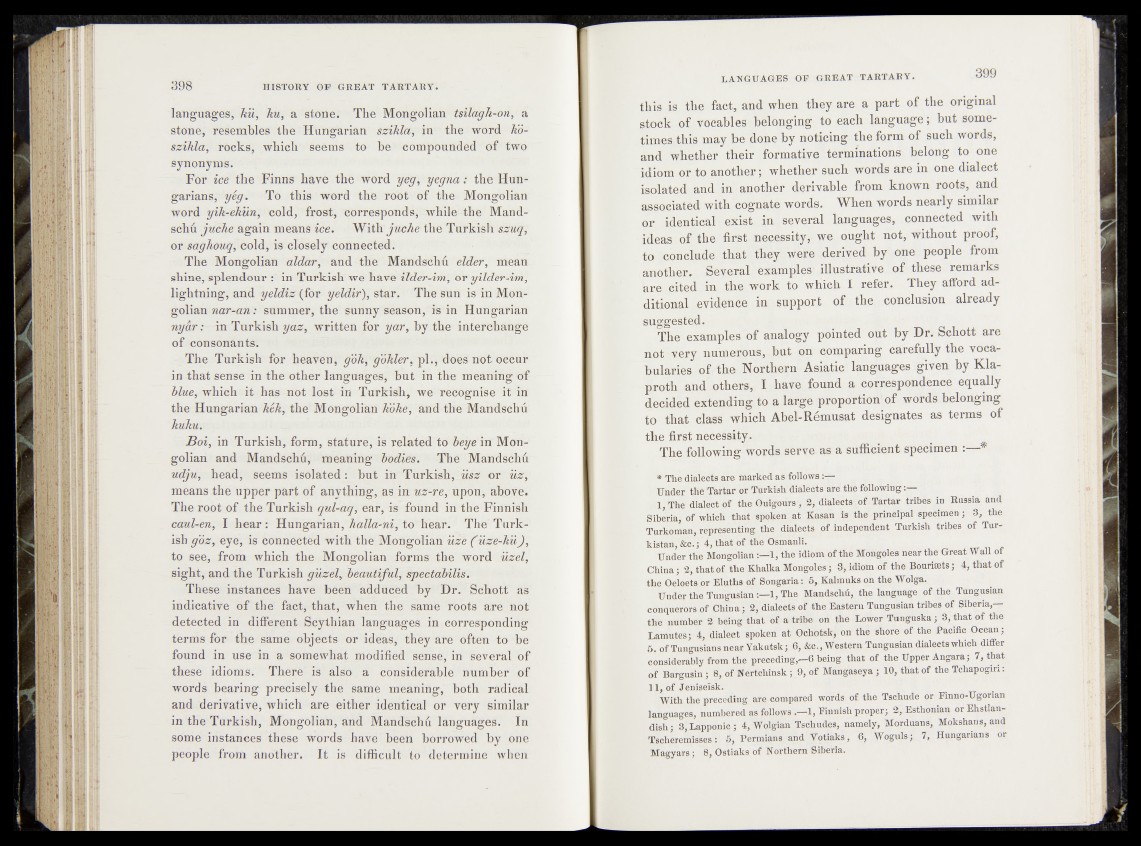
languages, kü, ku, a stonei^ The Mongolian tsilagh-on, a
stone,'resembles the Hungarian szikla, in the word Ko-
szikla, rocks, which seems to be compounded of two
synonyms: '
For ice the Finns have the word yeg3 yegna: the Hungarians,'
yêg. To this word the root of the Mongolian
word yik-ekiin, cold, frost, corresponds, while the Mandschu
juehe again means ice. With juche the Turkish szuq,
or saghouqScold, is closely connected.
The Mongolian aldar, and the Mandsehti elder, mean
shine, splendour in Turkish we have ilder-im, oYyildér-im,
lightning, and yeldiz (for yeldh% star. The sun is in Mongolian
n a r-a n summer, the sunny season, is; in Hungarian
ny&r: in Turkish yaz3 written for yar, by the interchange
of consonants.
The Turkish for heavert; gdk,'gohler^p]., does not oecur
in that sense in the other languages*'but in tie' meaning ’Of
blue, which it has -not lost in Turkish,' we'recognise*^ in
the Hungarian heh, the Mongolian and the MandsêfrJg
kuku.
JBoi, in Turkish, form, stature, is related to beye in Mongolian
and Mandschó, meaning bodies. The Mandséhfr
udju, head, seems isolated: but in Turkish, iisz or üz,
means the upper part of anything,
The root of the Turkish qid-aq, ear, is found in‘the Finnish
caul-en3 I hear: Hungarian, halla-ni, to hear. The?Turkish
góz, eye, is connected with the Mongolian üze (üze-küj,’
to see, from which the Mongolian forms the word uzel,
sight, and the Turkish giizel3 beautiful, spectabilis.
These instances have been adduced by Dr. Schott as
indicative of the fact, that, when the same Toots are not
detected in different Scythian languages in corresponding
terms for- the same objects or ideas, they are often to be
found in use in a somewhat modified sense, in several of
these idioms. There* is also a considerable number of
words bearing precisely the same meaning, both radical
and derivative, which are either identical or very similar
in the Turkish, Mongolian, and Mandschu languages. In
some instances these Words have been borrowed by one
people from another. It is difficult to determine when
this is the fact, and when they are a part of the original
Stock of vocables belonging to each language ; but sometimes
this may be done by noticing the form of such words,
and whether their formative terminations belong to one
idiom or to another; whether such words are in one dialect
isolated and in another derivable from known roots, and
associated with cognate words. When words nearly similar
or identical exist in,several languages, connected with
ideas of the first necessity;-, we ought not, without proof,
to conclude that jlhjey were iderived by one people from
another. Several'example^ illustrative of these remarks
are cited-.in the work to wliich I refer. They afford additional
evidence in support of the. conclusion already
suggest#., BK Hi !
The examples of analogy jointed out by Dr. Schott are
np&fvery numerous,, but on comparing carefully the voca-
b ulariesJpf/the Northern Asiatic languages given by Klaproth
and others, I have found a correspondence equally
decided extending to a large proportion’ of words belonging
to that class which Abel-Rémusat designates as terms of
the first necessity..
The following words serve as a sufficient specimen
* The dialects are marked a s - f o l l o w s -
i-Under tKe'Tartar or Turkish dialects are th'è following:—
l,T h e dialect .of the Ouigours-, 2, dialects of Tartar tribes in Russia and
Siberia, of which that spoken at Kasan is the principal specimen £v3, the
Turkoman, representing, the dialects of independent darkish tribes of Tur-
kistan, &c.; 4, that 8f ttfe Osmanli.
Unter the Mo n g o l i a n 1; théddïorh of the Mbhgoles near the Great Wall of
China; 2, that of the Khalka Mongoles ; 3, idiom Of the Bourimts; 4, that of
the Oeloets,,or Eluths of Songariafld, Ealipuks on the Wolga.
Under thé Tu n g u s i a n 1, The Mandschu, the language of the^Tungusian
conquerors of China; 2, dialects of-the Eastern Tungukian tribes of Siberia,—
the number 2 being that of a tribe-' on the loWer Tunguska; 3, that of the
Lamutesj-4, dialect spoken at Ochotski on the shore of the Pacific Ocean;
5. of Tungusians near Yakutsk; 6, &c., Western, Tungusian dialects which differ
considerably from the preceding,—6 being that of the Upper Angara; 7, that
of Bargusin; 8, of Nertchinsk ; 9, of Mangaseya; 10, that of the Tchapogin:
11, of Jeniseïsk. _ ' k | £
With the preceding areepmpared words, of the Tachudd or Finno-Ugorian
languages, numbered as follows .—1, Finnish proper; 2, Esthonian or Ehstlan-
dish; 8;, Lapponic; 4, Wolgian Tschudes, namely, Morduans, Mokshans, and
Tscheremisses jf> Permian* and V o le s ', 6 , !Woguls; 7 .^Hungarians Of;
Magyars; 8, Ostiaks of Northern Siberia.